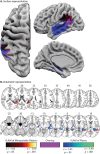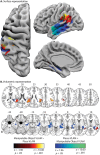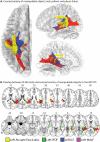This is a preprint.
Visual processing of manipulable objects in the ventral stream is modulated by inputs from parietal action systems
- PMID: 40501973
- PMCID: PMC12157446
- DOI: 10.1101/2025.06.01.657280
Visual processing of manipulable objects in the ventral stream is modulated by inputs from parietal action systems
Abstract
Functional object use requires the integration of visuomotor representations processed in the dorsal visual pathway with representations of surface texture and material composition of objects, processed in the ventral visual pathway. Do regions in the ventral visual pathway project outputs to dorsal visual pathway action systems, or are the outputs of the dorsal visual pathway communicated to the ventral visual pathway to modulate processing? And what are the white matter pathways that mediate structural connectivity in support of functional object use? Here we show that the left inferior parietal cortex, a region within the dorsal visual pathway, exerts a direct effect on neural responses in ventral occipital-temporal cortex during visual processing of manipulable objects. We studied a series of consecutively enrolled participants in the pre-operative phase of their neurosurgical care (N = 109) with lesions principally distributed throughout the left hemisphere. Participants completed an object processing category localizer functional MRI experiment in which they viewed images of manipulable objects, animals, faces, and places. We then used Voxel-based Lesion-Activity Mapping (VLAM), a technique in which functional responses in a region-of-interest are used to predict variance in voxel-wise lesion incidence throughout the brain. In the VLAM analyses performed here, we found that lesions to the left anterior intraparietal sulcus and left supramarginal gyrus, two inferior parietal regions known to support object-directed grasping and manipulation, respectively, cause reduced neural responses for manipulable objects (compared to faces, places and animals) in the fusiform gyrus. Parietal lesions do not affect neural responses during visual processing of places in the same region of the fusiform gyrus, even though places elicit stronger responses in the fusiform gyrus than manipulable objects. Seventy-five of 109 participants took part in a common diffusion MRI protocol, permitting a connectome-wide analyses relating white matter fiber integrity to the strength of functional responses for manipulable objects in the left fusiform gyrus. This analysis demonstrated that the descending portion of the left arcuate fasciculus mediates parietal-totemporal lobe connectivity for manipulable objects, supporting the integration of action representations with conceptual and perceptual attributes of objects. By combining voxel-based and connectome-wide lesion-symptom mapping methods with functional MRI, we have demonstrated that structural connectivity to dorsal visual pathway areas supporting skilled manual action shape category-specific neural responses for manipulable objects within the ventral visual pathway.
Keywords: Object-directed action; connectome-based lesion-activity mapping; left inferior parietal lobule; left medial fusiform gyrus; manipulable objects; voxel-based lesion-activity mapping.
Conflict of interest statement
Conflicts of interest BZM is an inventor of IP PCT/US2019/064015 for a process to develop predictive analytics in neurosurgery. BZM is also a co-founder, and Chief Science Officer, of MindTrace Technologies, Inc., which licenses said intellectual property from Carnegie Mellon University.
Figures




Similar articles
-
Peripuberty Is a Sensitive Period for Prefrontal Parvalbumin Interneuron Activity to Impact Adult Cognitive Flexibility.Dev Neurosci. 2025;47(2):127-138. doi: 10.1159/000539584. Epub 2024 Jun 3. Dev Neurosci. 2025. PMID: 38830346 Free PMC article.
-
Networks for proper versus common name retrieval: insights from causal mapping and new hypotheses.Brain Commun. 2025 Jun 25;7(4):fcaf256. doi: 10.1093/braincomms/fcaf256. eCollection 2025. Brain Commun. 2025. PMID: 40661329 Free PMC article. Review.
-
Neural substrates underlying multisensory stiffness perception via active touch and dynamic visual feedback.Imaging Neurosci (Camb). 2025 Mar 5;3:imag_a_00493. doi: 10.1162/imag_a_00493. eCollection 2025. Imaging Neurosci (Camb). 2025. PMID: 40800849 Free PMC article.
-
Domain-Specific Diaschisis: Lesions to Parietal Action Areas Modulate Neural Responses to Tools in the Ventral Stream.Cereb Cortex. 2019 Jul 5;29(7):3168-3181. doi: 10.1093/cercor/bhy183. Cereb Cortex. 2019. PMID: 30169596 Free PMC article.
-
How lived experiences of illness trajectories, burdens of treatment, and social inequalities shape service user and caregiver participation in health and social care: a theory-informed qualitative evidence synthesis.Health Soc Care Deliv Res. 2025 Jun;13(24):1-120. doi: 10.3310/HGTQ8159. Health Soc Care Deliv Res. 2025. PMID: 40548558
References
Publication types
Grants and funding
LinkOut - more resources
Full Text Sources
